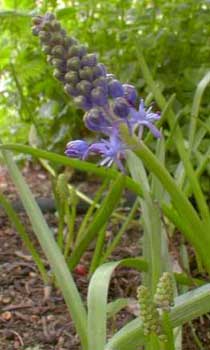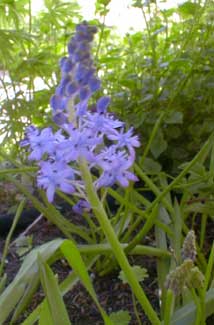
Amethyst Meadow Squill;
or, Dalmation Scilla
"The little fires that Nature lights --
The scilla's lamp, the daffodil --
She quenches, when of stormy nights
Her anger whips the hill."
-Joseph Campbell,
1904-1987
1904-1987
Good golly this is a pretty little flower. Scilla pratensis was formerly called S. litardierei & still often sold under the old name; & is also synonymous with S. amethystina, hence the common name Amethyst Squill. It was formerly a hard-to-find specialty bulb, but reached levels of mass production in 2004.
 Although suitable for woodland settings such as under deciduous trees, it is not as adaptable to shady conditions as English bluebells. Though somewhat forgiving of lighting conditions from full sun to partial shade (or inland perhaps even in deeper shade), with too much shade there is apt to be loss of flowering intensity. Ideal locations would be bright shade or partial sun, in moist well-draining soil. They will also grow nicely amidst short grasses.
Although suitable for woodland settings such as under deciduous trees, it is not as adaptable to shady conditions as English bluebells. Though somewhat forgiving of lighting conditions from full sun to partial shade (or inland perhaps even in deeper shade), with too much shade there is apt to be loss of flowering intensity. Ideal locations would be bright shade or partial sun, in moist well-draining soil. They will also grow nicely amidst short grasses.It is cold-hardy to 14 degrees F., making it less winter-hardy than most squills, so it will want a winter mulching in zone 5 or 6, but needing no special attention in zones 7-8.
They do occasionally die out of the garden for sundry reasons, such as very cold winters or wetness during summer dormancy. But if they like where they're at, they will naturalize rapidly, for the bulbs split frequently.
Native to Slovania, where it likes meadow grasslands best, it has been known to western European & English gardens since at least 1827, when it was first brought to England from Dalmatia.
The conical raceme of flowers is somewhat reminscent of some species of muscari, rather than the dangling bluebells on the usual Scilla or Hyacinthoides species. The florets become wide open stars, however, unlike the pinched-closed florets of muscaris. The first photo above shows an immature flower with just a couple of the buds opened at the bottom of the pyramid of buds. At this stage it is most grape-hyacinth-like.
Some of the flowers appear late April but it really gets going for May, lasting into June; so it keeps its flower-type present when the actual grape hyacinths are long gone. They can vary in height, from a half-foot to over a foot. They are quite fragrant too.
In color they range from mid-purple or lavender, to powder blue, to royal blue, so that bulbs from different sources may be quite distinct in color or darkness of the line down the center of each petal. Despite the range of color that can be found in these very free-flowering bulbs, there seems to be only one commonly offered named clone ('Orjen'); the various shades are not otherwise marketed as distinct colors, & gardeners just have to wait until they bloom to know their precise character.
So we obtained bulbs from two sources, as S. litardierei from Simple Pleasures, & correctly as S. pratensis from Langeveld, hoping the packagers didn't get them from the exact same grower, & keeping our fingers crossed for one being, perhaps, the pale porcelain-blue & the other the darker violet. Twenty-six of the bulbs were placed inside dripline of a butternut winterhazel, & nine slightly larger bulbs were planted close by, beside a young golden-leafed flowering currant. The larger bulbs turned out to start blooming about two weeks later but were otherwise pretty much the same porcelain blues.